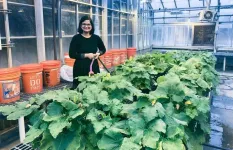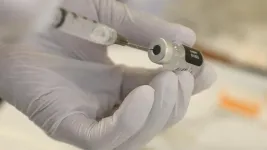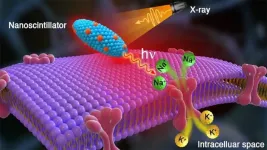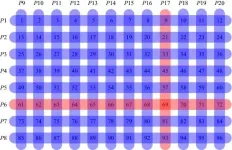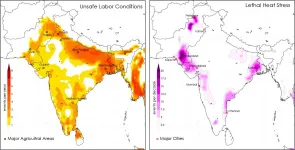(Press-News.org) PLYMOUTH MEETING, PA [March 25, 2021] -- New recommendations to advance racial equity, ways to mitigate the impacts of the COVID-19 pandemic on cancer care, and ongoing strategies for preventing and controlling HPV-associated cancers led the conversation at the National Comprehensive Cancer Network® (NCCN®) 2021 Virtual Annual Conference March 18-20. More than 1,300 attendees from across the United States and more than 40 countries met online to learn about updates to the NCCN Clinical Practice Guidelines in Oncology (NCCN Guidelines®) and new research in the field. Sessions explored supportive care and ways to help survivors return to work, updates on best practices, and the most contemporary treatments for multiple malignancies including breast cancer, non-small cell lung cancer, gynecologic cancers, and head and neck cancers.
"Despite a year-long pandemic that made both research and patient care more challenging, NCCN's panels of experts from leading academic cancer centers developed continuous updates to the NCCN Guidelines that helped oncology professionals worldwide maintain service to patients with best practices under evolving circumstances," said NCCN Chief Executive Officer Robert W. Carlson, MD.
"At the same time, it was a year of reckoning with the United States' history of racial inequity, in which NCCN and the greater healthcare community have been called with renewed urgency to develop ways to make quality cancer care more accessible and equitable."
Preventing and controlling HPV-associated cancers
The first of three keynote panels addressed the importance of vaccination, screening, public and professional education, and system/process improvement in preventing cancers common in people infected with HPV (human papillomavirus).
"HPV vaccination will have a significant impact on reducing cancer incidence in the U.S., as well as globally," said Wui-Jin Koh, MD, Chief Medical Officer, NCCN, who chaired the panel. "We know that vaccination against HPV can prevent most cases of cervical cancer, for example, yet many countries still have low vaccination rates, and misinformation about vaccines is rampant. Beyond cervical cancer, HPV is also causative in many cancers of the anus, vulvar, vagina, penis, and oropharynx. Strategies to increase vaccination and otherwise control HPV are vital to cancer prevention."
Elevating racial equity
At the conference, representatives from the Elevating Cancer Equity Working Group--convened by NCCN along with the American Cancer Society Cancer Action Network (ACS CAN) and the National Minority Quality Forum (NMQF)--discussed detailed recommendations for reducing racial disparities in cancer care. People of color--especially Black, Latinx, and Indigenous people--often have higher cancer rates and yet are medically underserved, experiencing later diagnosis and worse outcomes.
"These disparities result from systemic inequality and bias in access and care delivery," commented Dr. Carlson. "Oncology professionals have a responsibility to respond, and help ensure their patients have access to guideline-adherent cancer care."
Presenters Lisa A. Lacasse, MBA, President, ACS CAN and Elizabeth Harrington, Partner, Public Opinion Strategies (POS) took a deeper look at a recent poll commissioned by the working group that found 63% of African American and 67% of Latinx cancer patients, survivors, and caregivers reported negative interactions with their care team, compared with 43% of white patients. The presentation also included a real-time poll of the audience regarding the importance and feasibility of implementing the recommendations for improving equity in cancer care. In many cases, attendees reported that they already have these policies in place.
"This is where the rubber meets the road. You can have great ideas, but how they're operationalized is critical to any success. It feels big, but certainly people are doing it," said Robert Winn, MD, Director, Virginia Commonwealth University Massey Cancer Center who co-chaired the working group along with fellow presenter, Shonta Chambers, MSW, EVP Health Equity Initiatives and Community Engagement, Patient Advocate Foundation.
Adapting care in a pandemic
The COVID-19 pandemic forced oncology professionals to adapt in order to provide ongoing care for cancer patients--especially those at high risk. The final keynote session, "Effects of the Pandemic on Cancer Care/Future Directions of Cancer Care," reviewed the COVID-related difficulties cancer centers have faced, how they adapted, and the possibility of permanent shifts to incorporate more telemedicine.
"In a moment of crisis, it is important for us to meet the crisis but then to gain something that we carry forward," said Timothy Kubal, MD, MBA, Moffitt Cancer Center, Co-Chair, NCCN Best Practices Committee. "As healthcare providers, I think we are realizing that many of the things that we have held sacred aren't as important to the patient as we thought. The in-person visit, full physical exam and on-site labs, imaging and chemotherapy are the way things have been done for a generation, but telemedicine challenges many aspects of such tradition. We all thought this would be terrible for the patient but as it turns out, in most cases, it's okay. We need to carry this learning forward to better meet the needs of our patient population and to drive innovation in healthcare delivery.
They say the only thing that matters in real estate is 'location, location, location.' But, for our patients, what really matters is, 'What location works for you?'"
The NCCN Annual Conference convenes oncology professionals--physicians, nurses, pharmacists, researchers, payers, advocates, and policymakers--to advance cancer treatment and patient care by exploring emerging therapies and addressing the latest issues and updates. The virtual conference featured more than 35 educational sessions with interactive polling, and moderator-facilitated Q&A. The conference also featured more than 90 research posters and more than 50 virtual interactive exhibits.
The online conference platform will allow attendees to continue accessing all sessions until May 19, 2021. At that time, the sessions will be made available as recorded webcasts via the NCCN Continuing Education portal at education.nccn.org, with a clinical synopsis publishing in JNCCN-Journal of the National Comprehensive Cancer Network this summer. Take part in the post-conference discussion on social media by using the hashtag #NCCN2021, or visit END
NCCN 2021 Virtual Annual Conference addresses cancer care in a year of crisis and innovation
Live virtual conference drew global oncology professionals to share best practices and highlight advances and issues in cancer care
2021-03-25
ELSE PRESS RELEASES FROM THIS DATE:
Revealing complex behavior of a turbulent plume at the calving front of a Greenlandic glacier
2021-03-25
For the first time, scientists have succeeded in continuous monitoring of a subglacial discharge plume, providing a deeper understanding of the glacier-fjord environment.
As marine-terminating glaciers melt, the fresh water from the glacier interacts with the seawater to form subglacial discharge plumes, or convective water flows. These turbulent plumes are known to accelerate the melting and breakup (calving) of glaciers, drive fjord-scale circulation and mixing, and create foraging hotspots for birds. Currently, the scientific understanding of the dynamics of subglacial plumes based on direct measurements is limited to isolated instances.
A team of scientists consisting of Hokkaido University's Assistant Professor Evgeny A. Podolskiy and Professor Shin Sugiyama, and the ...
Genome sequenced for pesky pumpkin pathogen
2021-03-24
URBANA, Ill. - Pumpkin growers dread the tiny tan scabs that form on their fruit, each lesion a telltale sign of bacterial spot disease. The specks don't just mar the fruit's flesh, they provide entry points for rot-inducing fungus and other pathogens that can destroy pumpkins and other cucurbits from the inside out. Either way, farmers pay the price, with marketable yields reduced by as much as 90%.
Despite the disease's severity, scientists don't know much about the genetics of the pathogen that causes it; nearly all the molecular information required for accurate diagnostic testing and targeted treatments is lacking for the disease.
In a new study, University of Illinois scientists, with the help of two undergraduate students, have assembled the first complete ...
Harvard, Smithsonian astronomers help capture first image of black hole's magnetic fields
2021-03-24
Cambridge, MA - Astronomers have now obtained a new view of the supermassive black hole at the center of galaxy M87. Images released today by the Event Horizon Telescope (EHT) collaboration reveal how the black hole, some 55 million light-years away, appears in polarized light.
The image marks the first time astronomers have captured and mapped polarization, a sign of magnetic fields, so close to the edge of a black hole.
Scientists still don't understand how magnetic fields -- areas where magnetism affects how matter moves -- influence black hole activity. Do they help direct matter into the hungry mouths of black holes? Can ...
COVID-19 vaccines may not produce sufficient antibody response in transplant recipients
2021-03-24
When clinical trials were conducted to determine the immunogenicity -- the ability to elicit an immune response -- for the first two vaccines marshaled against SARS-CoV-2the virus that causes COVID-19, one group was not among those included: people who have received solid organ transplants and others (such as those with autoimmune disorders) who are immunocompromised.
Now, Johns Hopkins Medicine researchers have tried to rectify that inequity, taking one of the first looks at how people who are immunocompromised respond to their first dose of one of the two mRNA vaccines -- Moderna and Pfizer-BioNTech -- currently being administered worldwide. Their findings, as published March 15, 2021, in a research letter in the END ...
Survey of Geisinger employees shows increasing acceptance of COVID-19 vaccines
2021-03-24
DANVILLE, Pa. - A survey of Geisinger employees conducted over two weeks in December 2020 found a steady increase in intent among healthcare workers to receive the COVID-19 vaccine.
On Dec. 4, 2020, an announcement about anticipated vaccine availability was emailed to all 23,784 Geisinger employees. Recipients were asked to indicate their intention to receive a vaccine when one was available to them and the reasons for any hesitation they might have. More than two-thirds of employees responded to the survey.
Of those who completed the survey before Dec. 10, when an independent FDA advisory committee ...
Vaccine science and side effects: How news messages affect views on vaccination
2021-03-24
News coverage of expert scientific evidence on vaccine safety is effective at increasing public acceptance of vaccines, but the positive effect is diminished when the expert message is juxtaposed with a personal narrative about real side effects, new research has found.
The study, by researchers affiliated with the Annenberg Public Policy Center (APPC) of the University of Pennsylvania and the University of Illinois, tested the effects of messages about vaccination in televised news reports. These included video clips of Dr. Anthony Fauci, director of the U.S. National Institute of Allergy and Infectious Diseases, talking about evidence supporting the value and safety of the MMR (measles, mumps and rubella) vaccine, and a mother who's refusing to vaccinate ...
Shining a healing light on the brain
2021-03-24
Scientists make pivotal discovery of method for wireless modulation of neurons with X-rays that could improve the lives of patients with brain disorders. The X-ray source only requires a machine like that found in a dentist's office.
Many people worldwide suffer from movement-related brain disorders. Epilepsy accounts for more than 50 million; essential tremor, 40 million; and Parkinson's disease, 10 million.
Relief for some brain disorder sufferers may one day be on the way in the form of a new treatment invented by researchers from the U.S. Department of Energy's (DOE) Argonne National Laboratory and ...
Group testing method developed for COVID-19
2021-03-24
Researchers Mario Guarracino the HSE Laboratory of Algorithms and Technologies for Networks Analysis in Nizhny Novgorod and Julius ?ilinskas and Algirdas Lančinskas from Vilnius University, have proposed a new method of testing for COVID-19. This group method allows results to be obtained 13 times faster as compared to individual testing of each sample. The research paper was published in the journal Scientific Reports.
The COVID-19 pandemic has already affected millions of people from over 200 countries. The rapid virus expansion demonstrated how fast such infections can spread in today's globalized world. At the beginning of the pandemic, when little was known about the virus and vaccines had not yet ...
Deadly heat waves will be common in South Asia, even at 1.5 degrees of warming
2021-03-24
WASHINGTON--Residents of South Asia already periodically experience heat waves at the current level of warming. But a new study projecting the amount of heat stress residents of the region will experience in the future finds with 2 degrees Celsius of warming, the population's exposure to heat stress will nearly triple.
Limiting warming to 1.5 degrees Celsius will likely reduce that impact by half, but deadly heat stress will become commonplace across South Asia, according to the new study in Geophysical Research Letters, AGU's journal publishing high-impact, short-format reports with immediate implications spanning all Earth and space sciences.
With ...
Zooming in on muscle cells
2021-03-24
An old technique flexes its muscles
Sarcomeres are small repeating subunits of myofibrils, the long cylinders that bundle together to make the muscle fibres. Inside the sarcomeres, filaments of the proteins myosin and actin interact to generate muscle contraction and relaxation. So far, traditional experimental approaches to investigate the structure and function of muscle tissue were performed on reconstructed protein complexes or suffered from low resolution. "Electron cryo-tomography, instead, allows us to obtain detailed and artefact-free 3D images of the frozen muscle", says Raunser.
Cryo-ET was for a long time an established yet niche methodology. But recent technical advances in electron cryo-microscopy (cryo-EM) as well as the new development of ...
LAST 30 PRESS RELEASES:
University of Oklahoma researcher awarded funding to pursue AI-powered material design
Exploring how the visual system recovers following injury
Support for parents with infants at pediatric check-ups leads to better reading and math skills in elementary school
Kids’ behavioral health is a growing share of family health costs
Day & night: Cancer disrupts the brain’s natural rhythm
COVID-19 vaccination significantly reduces risk to pregnant women and baby
The role of vaccination in maternal and perinatal outcomes associated with COVID-19 in pregnancy
Mayo Clinic smartwatch system helps parents shorten and defuse children's severe tantrums early
Behavioral health spending spikes to 40% of all children’s health expenditures, nearly doubling in a decade
Digital cognitive behavioral treatment for generalized anxiety disorder
Expenditures for pediatric behavioral health care over time and estimated family financial burden
Air conditioning in nursing homes and mortality during extreme heat
The Alps to lose a record number of glaciers in the next decade
What makes a good proton conductor?
New science reporting guide published for journalists in Bulgaria
New international study reveals major survival gaps among children with cancer
New science reporting guide published for journalists in Turkey
Scientists develop a smarter mRNA therapy that knows which cells to target
Neuroanatomy-informed brain–machine hybrid intelligence for robust acoustic target detection
Eight SwRI hydrogen projects funded by ENERGYWERX
The Lundquist Institute and its start-up company Vitalex Biosciences Announces Strategic Advancement of Second-Generation fungal Vaccine VXV-01 through Phase 1 Trials under $40 Million Competitive Con
Fine particles in pollution are associated with early signs of autoimmune disease
Review article | Towards a Global Ground-Based Earth Observatory (GGBEO): Leveraging existing systems and networks
Penn and UMich create world’s smallest programmable, autonomous robots
Cleveland researchers launch first major study to address ‘hidden performance killer’ in athletes
To connect across politics, try saying what you oppose
Modulating key interaction prevents virus from entering cells
Project explores barriers to NHS career progression facing international medical graduates
Jeonbuk National University researchers explore the impact of different seasonings on the flavor perception of Doenjang soup
Two Keck Medicine of USC Hospitals named Leapfrog Top Teaching Hospitals
[Press-News.org] NCCN 2021 Virtual Annual Conference addresses cancer care in a year of crisis and innovationLive virtual conference drew global oncology professionals to share best practices and highlight advances and issues in cancer care
